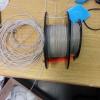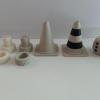Feedstock recycling and pyrolysis from waste plastics
According to the World Economic Forum plastics use grows worldwide at 5% per year. Packaging sector covers the largest production and at the same time is responsible for most waste plastics generated: moreover about 30% of plastic packaging escapes collection systems, damaging vital natural systems such as the ocean and clogging urban infrastructure. Not only plastics coming from short-cycle consumption but also from durable goods pose an economic and environmental challenge to our end of life management. It is estimated that plastics from waste electric and electronic equipment (WEEE), accounting for 30% wt. is produced worldwide at a pace of 12 Mt each year. This material results as a complex mixture of many different polymers, the structure of which is modified by the intensive use of additives such as polybrominated flame retardants. . Mechanical recycling is not always a viable option to heterogeneous and contaminated materials, and, when it is, it may not result economically and environmentally convenient.
Therefore, a suitable method for recycling plastics, is still a subject of research. An alternative and promising route of treatment is represented by the feedstock recycling through pyrolysis, which thermally breaks down the polymer chains into valuable products. This stream consists of hydrocarbon chemical intermediates in the form of synthetic oil, gas and carbonaceous solid residue (char). Oil can be further processed into monomers or alternative petrochemical products, while the gas may be converted into a gas for the synthesis of chemicals, while char into an activated carbon. All the three products are also potential fuels because of their high energy content.. The yields of products and their composition depend on the process operating conditions and on the kind of plastic to be pyrolysed.
The laboratory of technologies for the waste integrated management set up a pyrolysis process for heterogeneous commingled plastics both of packaging and WEEE. Main aims of this activities are:
1) Investigation of effects induced by degradation temperature and the use of zeolitic catalysts on the yield and composition of final products.
2) Optimization of operating process conditions
3) Products qualification for chemical industries
Available facilities are three pyrolysis bench reactors provided with various configurations, condensation units and gas collecting systems.
Analytical instrumentation allows to characterize input and output materials: elemental analysis (C, H, N, S, O, Cl), high heating value direct measurement, TG/DSC/FT-IR, GC-FID/TCD.




